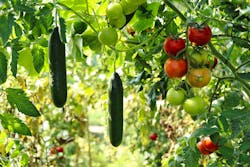Austin, TX–based horticultural lighting firm Fluence by Osram has indeed grown impressively on the back of liberalized cannabis laws that have prompted a rush for LED lighting by cultivators.
But as LEDs Magazine noted recently, it’s not all about cannabis in Austin. Fluence — known as Fluence by Osram until Signify completes a planned acquisition of the company — helps other crops flourish, too.
We last dished out that observation with strawberries. Now, Fluence has served up yet another example, as it introduced two LED luminaires targeted at what it says are “high density vine crops tomatoes and cucumbers” in greenhouses.
The luminaires in the new VYNE series are intended for placement among the plants rather than above as toplighting. Fluence refers to this style as “intercanopy lighting,” which is the same concept that Signify calls “interlighting.”
Whatever you call it, the idea is to supplement toplighting in greenhouses and indoor farms, or vice versa. Intercanopy lighting with its lower height delivers photons directly to parts of the plant that might be shaded from toplights. One issue with intercanopy lighting is that, being close to the plant, its heat can be damaging. LEDs reduce this risk compared to conventional high-pressure sodium (HPS) light sources that generate excess heat.
“With VYNE, photosynthetically active radiation reaches leaves lower in the canopy, improving photosynthesis and ultimately increasing plant yield,” Fluence said. “Cultivators can also leverage VYNE in greenhouses with lower ceilings where toplight installation is limited.”
Fluence is offering VYNE in two standard spectra. Its BROAD R6 model concentrates heavily on delivering red wavelengths while offering a low dose of blue and lower doses of green and yellow stretches. The Dual R9B has a similar red dose and a smaller blue dose, while cutting out the green and yellow, as indicated by a spec sheet on the Fluence website.
Both fittings are available in 2.5m and 2.1m lengths. At 2.5m, each delivers a photosynthetic photon flux (PPF) of 300 μmol/s. The 2.1m versions deliver 240 μmol/s.
The DUAL R9B has a higher efficacy rating — 3.3 μmol/J at 277 VAC compared to 3.0 μmol/J at 277 VAC for the BROAD R6.
Fluence said that up to 40 fixtures can be daisy-chained together off a single power source.
The new intercanopy lights mark the second time this month that Fluence has introduced new lighting products. Its latest SPYDR models, aimed at cannabis cultivation, have a PPF as high as 2,100 μmol/s. They rated below the VYNE models in efficacy.
Meanwhile, Fluence, which has grown into a $141 million business over eight years, continues to point out that navigating the cannabis trade is not for the fainthearted. Regulatory challenges can also impact the financial backing of cannabis businesses and therefore create obstacles to implementing energy-efficient systems, according to a recent article by CEO George Mekhtarian of horticultural SSL manufacturer California Lightworks.
MARK HALPER is a contributing editor for LEDs Magazine, and an energy, technology, and business journalist ([email protected]).
For up-to-the-minute LED and SSL updates, why not follow us on Twitter? You’ll find curated content and commentary, as well as information on industry events, webcasts, and surveys on our LinkedIn Company Page and our Facebook page.

Mark Halper | Contributing Editor, LEDs Magazine, and Business/Energy/Technology Journalist
Mark Halper is a freelance business, technology, and science journalist who covers everything from media moguls to subatomic particles. Halper has written from locations around the world for TIME Magazine, Fortune, Forbes, the New York Times, the Financial Times, the Guardian, CBS, Wired, and many others. A US citizen living in Britain, he cut his journalism teeth cutting and pasting copy for an English-language daily newspaper in Mexico City. Halper has a BA in history from Cornell University.





